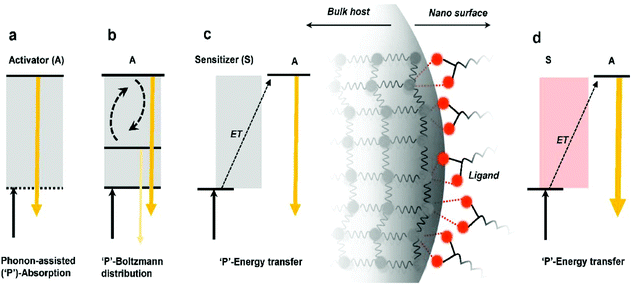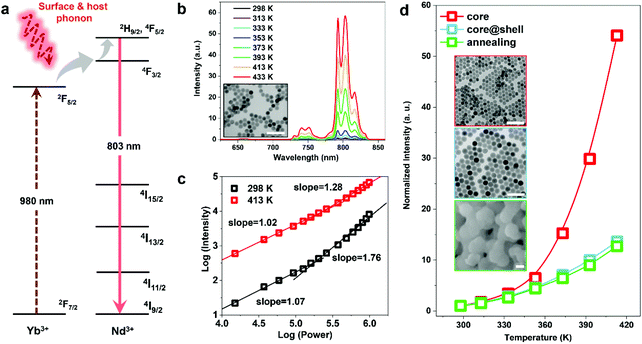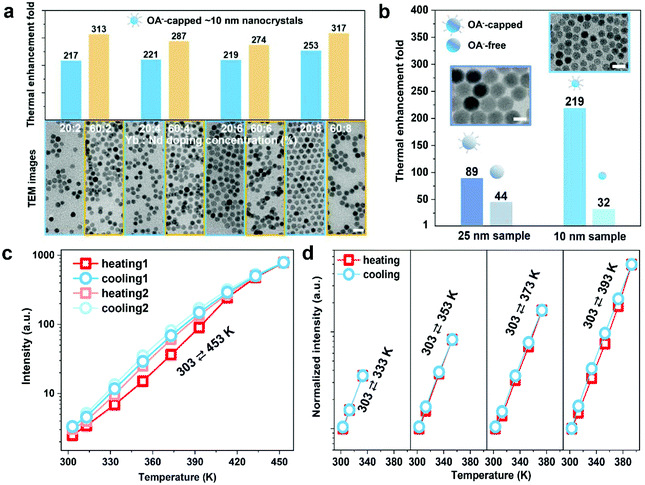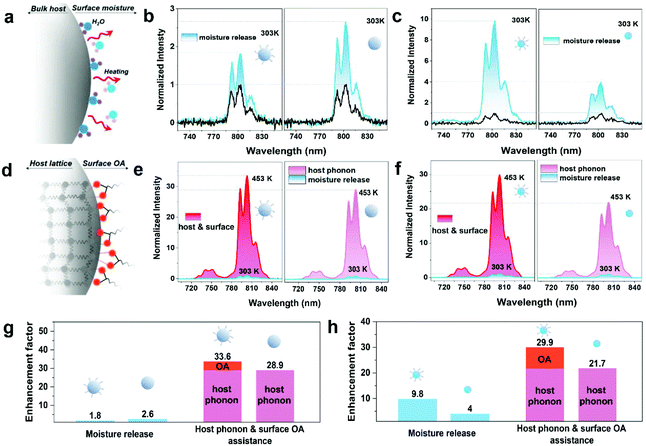Thermally enhanced NIR–NIR anti-Stokes emission in rare earth doped nanocrystals†
Chao
Mi
 ,
Jiajia
Zhou
,
Jiajia
Zhou
 *,
Fan
Wang
*,
Fan
Wang
 and
Dayong
Jin
and
Dayong
Jin

Institute for Biomedical Materials and Devices (IBMD), Faculty of Science, University of Technology Sydney, NSW 2007, Australia. E-mail: jiajia.zhou@uts.edu.au
First published on 10th June 2019
Abstract
Nanoparticles with anti-Stokes emissions have enabled many sensing applications, but their efficiencies are considerably low. The key to enable the process of anti-Stokes emissions is to create phonons that assist the excited photons to be pumped from a lower energy state onto a higher one. Increasing the temperature will generate more phonons, but it unavoidably quenches the luminescence. Here by quantifying the number of phonons being generated from the host crystal and those at the surface of Yb3+/Nd3+ co-doped nanoparticles, we systematically investigated mechanisms towards the large enhancements of the phonon-assisted anti-Stokes emissions from 980 nm to 750 nm and 803 nm. Moreover, we provided direct evidence that moisture release from the nanoparticle surface at high temperature was not the main reason. We further demonstrated that the brightness of 10 nm nanoparticles was enhanced by more than two orders of magnitude, in stark contrast to the thermal quenching effect.
The anti-Stokes emission process, where radiative transitions occur at energy levels higher than that of the absorbed excitation photons, has enabled a wealth of optical techniques, such as micro-imaging,1,2 laser cooling,3,4 coherent anti-Stokes Raman spectroscopy (CARS),5,6 photon energy upconversion,7,8 and optical thermometry.9,10 In particular, nanoscopic probes with anti-Stokes emission properties, like the multi-photon upconversion nanoparticles, are highly attractive for many emerging applications in optical imaging and nanoscale sensing, as it can efficiently reduce the excitation scatterings and remove the autofluorescence by using NIR pump source.11–16
Compared with the multi-photon upconversion process, the phonon-assisted linear anti-Stokes system only needs one lower-energy photon to produce one higher-energy photon, but it is hard to achieve high efficiency when the anti-Stokes shift is relatively large. As illustrated in Fig. 1, to promote the unusual anti-Stokes emission process and meet the energy gaps, phonons, which represent an excited quantum state of vibration within a material's elastic structure, play an essential role. Conventional mechanisms to promote more anti-Stokes emissions include excited state absorption of phonons (Fig. 1a), Boltzmann distribution (Fig. 1b), and the phonon-assisted energy transfer process (Fig. 1c), which often happen inside the crystal hosts and require increased temperature to favour the generation of more phonons.17,18 But higher temperature often ‘kills’ the emission intensity, known as the thermal quenching effect. Therefore, the solutions are often around the exploration of more efficient host materials for generating heat-favourable phonons and suitable management of the thermal quenching effect.19 It becomes more challenging when developing a nanoscopic anti-Stokes optical probe, as the increased amount of quenchers on the relatively large surface becomes more active in decreasing the brightness of the nanoparticle probes at increased temperature.20
In the search for highly efficient nanomaterials with a large anti-Stokes shift, inorganic nanomaterial systems have been investigated to produce linear anti-Stokes emissions, including CdSe(Te)/CdS/CdSe quantum dots with an anti-Stokes shift of 110 nm from 680 nm to 570 nm,21 carbon dots from 1100 nm to 984 nm,22 CsPbBr3 perovskite nanocrystals from 532 nm to 518 nm,23 CdS nanobelts from 532 nm to 496 nm,24 and h-BN from 610 nm to 565 nm.25 These material systems commonly suffer from the lack of a pair of suitable excited states as the ‘stepping-stones’ to facilitate energy transfer, and thereby their anti-Stokes emissions depend on the contingency of the defects or the bandgap restricted reconstruction.
Lanthanide doped luminescent nanomaterials can be an excellent candidate for linear anti-Stokes emission, due to the characteristic ‘ladder-like’ multiple excited states of lanthanides, showing inherent long lifetimes on a typical microsecond scale.26 However, most experimental demonstrations have been limited to bulk materials, e.g. Yb3+ and Nd3+ co-doped CaWO4 and La2O3, by taking advantage of their maximum phonon energies in the range of ∼800 cm−1 and ∼500 cm−1, that can thermally enhance the anti-Stokes emissions of Nd3+ by nearly 200-fold at a high temperature of 853 K.27,28 For nanoparticles, previous research only reported the NaYF4 nanocrystals with a thermal enhancement of 1.8-fold at 420 K.29
Here we report the dramatically enhanced linear anti-Stokes emissions from the lanthanide doped luminescent NaYF4:Yb3+,Nd3+ nanocrystal system. This takes advantage of the phonons generated at the surface of nanomaterials (illustrated in Fig. 1d) to break through the limitation in producing the highly efficient linear anti-Stokes emissions.
The schematic energy levels of Yb3+ and Nd3+ in the β-NaYF4 host material (Fig. 2a) show energy mismatches of 1200 cm−1 from Yb3+:2F5/2 to Nd3+:4F3/2 and an additional 1100 cm−1 to Nd3+:2H9/2,4F5/2.30 To produce the NIR to NIR anti-Stokes emissions from Nd3+ with a large shift (∼180 nm), several phonons are needed to fill the big energy gaps, if only low-frequency phonons are being generated from the host lattice vibration (smaller than 355 cm−1).31 What is more in this case, in the presence of the oleate ligand (OA) bonding with Yb3+ at the surface, the more appropriate phonon modes generated at the surface with vibration frequencies within the 510–560 cm−1 range can benefit the energy transfer.19 Thus, an enhancement factor of 136-fold was observed from the 2H9/2, 4F5/2 → 4I9/2 transitions (∼803 nm) of 25 nm β-NaYF4:20% Yb3+,6% Nd3+ nanocrystals when the temperature increased from 298 K to 433 K (Fig. 2b).
To confirm what we observed was not the cooperative two-photon upconversion process but the linear one-photon energy transfer,28 we first tested the power dependence of the 803 nm transitions at room temperature, and found as long as the excitation power density was smaller than 2 × 105 W cm−2 the anti-Stokes emissions from Nd3+ were a linear process (Fig. 2c). We then tested the power dependence at 413 K and observed the smaller double-log intensity-power slopes at 413 K than that at 298 K (Fig. 2c), which indicated that the phonon-assisted one-photon upconversion was even more pronounced at high temperature because of the availability of more active phonons. As predicted, the cooperative two-photon upconversion process only appeared obviously under an extremely high excitation power at low temperature. These findings have confirmed the linear anti-Stokes emissions from the Yb3+/Nd3+ co-doped nanoparticles realized by phonon assistance especially at high temperature.
To demonstrate the important role of surface phonons that make the anti-Stokes emission more efficient in a thermal field, we also collected the evidence by reverse logic by checking nanomaterials without an effective surface ligand. The contrastive samples included the nanocrystals passivated with an inert shell (NaYF4:20% Yb3+,6% Nd3+@NaYF4) to block the phonon assistance from the surface and the samples annealed at 773 K for 3 hours to remove OA. As shown in Fig. 2d, we found both control samples without the active surface only resulted in ∼13-fold intensity enhancement when the temperature increased from 298 K to 413 K, while the core-only 20 nm nanocrystals with the active surface exhibited a 55-fold enhancement under the same measurement conditions. Such a difference shows the effectiveness of the active surface in enhancing the anti-Stokes luminescence.
To further optimise the enhancement factor and achieve strong anti-Stokes emission in NaYF4:Yb3+,Nd3+ nanoparticles, we prepared a series of ∼10 nm nanocrystals to take advantage of their relatively large surface area for surface phonon assistance. TEM results confirmed that all eight samples with various doping concentrations had quite similar sizes of around 10 nm (Fig. 3a and Fig. S1†), and showed a significant amount of enhancement by more than two orders of magnitude after the temperature increased to 453 K (Fig. 3a). Interestingly, we found that the nanoparticles with a higher Yb3+ concentration of 60% constantly provided stronger enhancement compared to 20% Yb3+ doped samples; as the influence caused by different sample sizes can be ignored here, it can only be explained by more bindings between OA and Yb3+ ions in high Yb3+-doped samples as shown in Fig. 1d.19 Additionally, the quantitative assessment indicated that the enhancement factor had no obvious correlation with the absolute intensity of the nanocrystals (Fig. S2†). Furthermore, by removing OA from both 10 nm and 25 nm samples’ surface (confirmed by FTIR in Fig. S3†), we observed the apparent difference that the enhancement in the OA-capped samples was much higher than that in the OA-free samples (Fig. 3b).
Except for the demonstrated surface and host phonon assistance, there are also some other effects that may lead to the thermally induced luminescence enhancement.32–34 To clarify the possible effects, we first measured the temperature-dependent spectroscopy of Nd3+ singly doped samples, to check the Boltzmann distribution influence among the energy states of 4I9/2 and 4I11/2 in Nd3+ ions35,36 (Fig. S4†). Although the Boltzmann distribution can increase the ∼800 nm emission at an elevated temperature, the enhancement was far less than that caused by the proposed phonon assistance. We then carried out the heating–cooling cycle test (Fig. 3c). The reversible emission intensity and consistent surface ligand (see FTIR in Fig. S5†) before and after the cycle excluded the high temperature annealing effect, which could cause an intrinsic structure change of the sample. But the observed hysteresis behaviour did hint towards the possible activation of the quenched sites, in consideration of the fact that the relatively large surface of nanoparticles could produce a mass of surface quenchers. As a recent report argued that the thermally induced moisture release may have contributed to the enhancement,32 we have further monitored the hysteresis effect with different maximum temperatures (Fig. 3d), and found the hysteresis effect gradually became obvious at a higher heating point applied to the sample. These results indicated a possible desorption and readsorption process of the water molecules during the heating–cooling cycles.
To further prove the phonon assistance from the host and surface could play the dominant role in the anti-Stokes emission enhancement, instead of the moisture release (Fig. 4a), we retested the 25 nm and 10 nm samples in a moisture-free environment before and after removing OA on the surface. We evaluated the moisture-free conditions by keeping the samples at 453 K and in an Ar filled environment until achieving stabilized emission intensities (Fig. S6 and S7†), and subsequently reduced the temperature to 303 K. As shown in Fig. 4b and c, we obtained the emission spectra before and after moisture release (Fig. S8†), which corresponded to enhancement factors of 1.8 and 2.6 fold in the 25 nm OA-capped and OA-free samples, and 9.8 and 4 fold for the 10 nm OA-capped and OA-free samples, respectively. Significantly, without the interference from moisture, with additional surface phonon assistance (Fig. 4d), we found OA-capped nanoparticles had stronger thermal enhancement than OA-free nanoparticles for both 25 nm and 10 nm samples, as shown in Fig. 4e and f. The quantitative results clearly showed that the assistance of OA contributed to the thermal enhancement from a factor of 28.9 to 33.6 in the 25 nm sample (Fig. 4g), and from 21.7 to 29.9 in the 10 nm sample (Fig. 4h), which has confirmed the essential role of the surface mode in the enhancement. It is worth noting that compared to the 25 nm nanoparticles, the 10 nm nanoparticles exhibited stronger effects associated with both mechanisms of the moisture release and OA assistance, which might be due to the higher surface to volume ratio of the 10 nm sample.
In summary, by achieving the unusually large enhancement for the one-photon anti-Stokes luminescence in Yb3+/Nd3+ co-doped nanosystems, at high temperature, and particularly for ultra-small nanoparticles (∼10 nm in diameter), this work suggests a large scope for fundamental research on further investigating the phonon-assisted photon conversion process and physical chemistry aspects on the surface of luminescent nanomaterials. This work further suggests new ways in designing anti-thermal-quenching phosphors, highly efficient sensors, and temperature-responsive nanophotonic devices for practical applications in the broad areas of bio-imaging, laser cooling, CARS spectroscopy, and nanoscale thermometry.
Conflicts of interest
There are no conflicts to declare.Acknowledgements
The authors acknowledge the financial support from the Australian Research Council Discovery Early Career Researcher Award Scheme (J. Z., DE180100669), National Natural Science Foundation of China (61729501), and Major International (Regional) Joint Research Project of NSFC (51720105015).References
- Q. Liu, Y. Zhang, C. S. Peng, T. Yang, L. M. Joubert and S. Chu, Single upconversion nanoparticle imaging at sub-10 W cm−2 irradiance, Nat. Photonics, 2018, 12, 548–553 CrossRef CAS.
- Y. Liu, Y. Lu, X. Yang, X. Zheng, S. Wen, F. Wang, X. Vidal, J. Zhao, D. Liu, Z. Zhou, C. Ma, J. Zhou, J. A. Piper, P. Xi and D. Jin, Amplified stimulated emission in upconversion nanoparticles for super-resolution nanoscopy, Nature, 2017, 543, 229–233 CrossRef CAS PubMed.
- A. T. M. Anishur Rahman and P. F. Barker, Laser refrigeration, alignment and rotation of levitated Yb3+:YLF nanocrystals, Nat. Photonics, 2017, 11, 634–638 CrossRef.
- S. T. Ha, C. Shen, J. Zhang and Q. Xiong, Laser cooling of organic–inorganic lead halide perovskites, Nat. Photonics, 2015, 10, 115–121 CrossRef.
- Y. Zhang, Y. R. Zhen, O. Neumann, J. K. Day, P. Nordlander and N. J. Halas, Coherent anti-stokes raman scattering with single-molecule sensitivity using a plasmonic Fano resonance, Nat. Commun., 2014, 5, 4424 CrossRef CAS PubMed.
- N. Dudovich, D. Oron and Y. Silberberg, Single-pulse coherently controlled nonlinear raman spectroscopy and microscopy, Nature, 2002, 418, 512–514 CrossRef CAS PubMed.
- F. Auzel, Upconversion and anti-stokes processes with f and d Ions in Solids, Chem. Rev., 2004, 104, 139–173 CrossRef CAS PubMed.
- B. Zhou, B. Shi, D. Jin and X. Liu, Controlling upconversion nanocrystals for emerging applications, Nat. Nanotechnol., 2015, 10, 924–936 CrossRef CAS PubMed.
- X. Zhu, W. Feng, J. Chang, Y. W. Tan, J. Li, M. Chen, Y. Sun and F. Li, Temperature-feedback upconversion nanocomposite for accurate photothermal therapy at facile temperature, Nat. Commun., 2016, 7, 10437 CrossRef CAS PubMed.
- S. Balabhadra, M. L. Debasu, C. D. Brites, L. A. Nunes, O. L. Malta, J. Rocha, M. Bettinelli and L. D. Carlos, Boosting the sensitivity of Nd3+-based luminescent nanothermometers, Nanoscale, 2015, 7, 17261–17267 RSC.
- W. Zheng, P. Huang, Z. Gong, D. Tu, J. Xu, Q. Zou, R. Li, W. You, J. G. Bunzli and X. Chen, Near-infrared-triggered photon upconversion tuning in all-inorganic cesium lead halide perovskite quantum dots, Nat. Commun., 2018, 9, 3462 CrossRef PubMed.
- Q. Zhan, H. Liu, B. Wang, Q. Wu, R. Pu, C. Zhou, B. Huang, X. Peng, H. Agren and S. He, Achieving high-efficiency emission depletion nanoscopy by employing cross relaxation in upconversion nanoparticles, Nat. Commun., 2017, 8, 1058 CrossRef PubMed.
- X. Lin, X. Chen, W. Zhang, T. Sun, P. Fang, Q. Liao, X. Chen, J. He, M. Liu, F. Wang and P. Shi, Core-shell-shell upconversion nanoparticles with enhanced emission for wireless optogenetic inhibitio, Nano Lett., 2018, 18, 948–956 CrossRef CAS PubMed.
- A. Fernandez-Bravo, K. Yao, E. S. Barnard, N. J. Boys, E. S. Levy, B. Tian, C. A. Tajon, L. Moretti, M. V. Altoe, S. Aloni, K. Beketayev, F. Scotognella, B. E. Cohen, E. M. Chan and P. J. Schuck, Continuous-wave upconverting nanoparticle microlasers, Nat. Nanotechnol., 2018, 13, 572–577 CrossRef CAS PubMed.
- M. Xu, X. Zou, Q. Su, W. Yuan, C. Cao, Q. Wang, X. Zhu, W. Feng and F. Li, Ratiometric nanothermometer in vivo based on triplet sensitized upconversion, Nat. Commun., 2018, 9, 2698 CrossRef PubMed.
- J. Xu, L. Xu, C. Wang, R. Yang, Q. Zhuang, X. Han, Z. Dong, W. Zhu, R. Peng and Z. Liu, Near-infrared-triggered photodynamic therapy with multitasking upconversion nanoparticles in combination with checkpoint blockade for immunotherapy of colorectal cancer, ACS Nano, 2017, 11, 4463–4474 CrossRef CAS PubMed.
- B. del Rosal, E. Ximendes, U. Rocha and D. Jaque, In vivo luminescence nanothermometry: from materials to applications, Adv. Opt. Mater., 2017, 5, 1600508 CrossRef.
- C. D. S. Brites, P. P. Lima, N. J. Silva, A. Millan, V. S. Amaral, F. Palacio and L. D. Carlos, Thermometry at the nanoscale, Nanoscale, 2012, 4, 4799–4829 RSC.
- J. Zhou, S. Wen, J. Liao, C. Clarke, S. A. Tawfik, W. Ren, C. Mi, F. Wang and D. Jin, Activation of the surface dark-layer to enhance upconversion in a thermal field, Nat. Photonics, 2018, 12, 154–158 CrossRef CAS.
- S. F. Lim, W. S. Ryu and R. H. Austin, Particle size dependence of the dynamic photophysical properties of NaYF4:Yb, Er nanocrystals, Opt. Express, 2009, 18, 2309–2316 CrossRef PubMed.
- Z. Deutsch, L. Neeman and D. Oron, Luminescence upconversion in colloidal double quantum dots, Nat. Nanotechnol., 2013, 8, 649–653 CrossRef CAS PubMed.
- N. Akizuki, S. Aota, S. Mouri, K. Matsuda and Y. Miyauchi, Efficient near-infrared up-conversion photoluminescence in carbon nanotubes, Nat. Commun., 2015, 6, 8920 CrossRef CAS PubMed.
- B. J. Roman and M. Sheldon, The role of mid-gap states in all-inorganic CsPbBr3 nanoparticle one photon up-conversion, Chem. Commun., 2018, 54, 6851–6854 RSC.
- Y. V. Morozov, S. Draguta, S. Zhang, A. Cadrane, Y. Wang, B. Janko and M. Kuno, Defect-mediated CdS nanobelt photoluminescence up-conversion, J. Phys. Chem. C, 2017, 121, 16607–16616 CrossRef CAS.
- Q. Wang, Q. Zhang, X. Zhao, X. Luo, C. P. Y. Wong, J. Wang, D. Wan, T. Venkatesan, S. J. Pennycook, K. P. Loh, G. Eda and A. T. S. Wee, Photoluminescence upconversion by defects in hexagonal boron nitride, Nano Lett., 2018, 18, 6898–6905 CrossRef CAS PubMed.
- L. Zhou, Y. Fan, R. Wang, X. Li, L. Fan and F. Zhang, High-capacity upconversion wavelength and lifetime binary encoding for multiplexed biodetection, Angew. Chem., Int. Ed., 2018, 57, 12824–12829 CrossRef CAS PubMed.
- W. Xu, Q. Song, L. Zheng, Z. Zhang and W. Cao, Optical temperature sensing based on the near-infrared emissions from Nd3+/Yb3+ codoped CaWO4, Opt. Lett., 2014, 39, 4635–4638 CrossRef CAS PubMed.
- G. Gao, D. Busko, S. Kauffmann-Weiss, A. Turshatov, I. A. Howard and B. S. Richards, Wide-range non-contact fluorescence intensity ratio thermometer based on Yb3+/Nd3+ co-doped La2O3 microcrystals operating from 290 to 1230 K, J. Mater. Chem. C, 2018, 6, 4163–4170 RSC.
- W. Xu, H. Qi, L. Zheng, Z. Zhang and W. Cao, Multifunctional nanoparticles based on the Nd3+/Yb3+ codoped NaYF4, Opt. Lett., 2015, 40, 5678–5681 CrossRef PubMed.
- G. H. Dieke, in Spectra and energy levels of rare earths in crystal, Wiley Interscience, 1968 Search PubMed.
- J. Shan, M. Uddi, N. Yao and Y. Ju, Anomalous raman scattering of colloidal Yb3+,Er3+ codoped NaYF4 nanophosphors and dynamic probing of the upconversion luminescence, Adv. Funct. Mater., 2010, 20, 3530–3537 CrossRef CAS.
- Y. Hu, Q. Shao, P. Zhang, Y. Dong, F. Fang and J. Jiang, Mechanistic investigations on the dramatic thermally induced luminescence enhancement in upconversion nanocrystals, J. Phys. Chem. C, 2018, 122, 26142–26152 CrossRef CAS.
- W. Yu, W. Xu, H. Song and S. Zhang, Temperature-dependent upconversion luminescence and dynamics of NaYF4:Yb3+/Er3+ nanocrystals: influence of particle size and crystalline phase, Dalton Trans., 2014, 43, 6193–6147 Search PubMed.
- D. Li, Q. Shao, Y. Dong, F. Fang and J. Jiang, Ho3+(or Tm3+)-activated upconversion nanomaterials: anomalous temperature dependence of upconversion luminescence and applications in multicolor temperature indicating and security, Part. Part. Syst. Charact., 2015, 32, 728–733 CrossRef CAS.
- L. Marciniak, K. Prorokb and A. Bednarkiewicz, Size dependent sensitivity of Yb3+,Er3+ up-converting luminescent nano-thermometers, J. Mater. Chem. C, 2017, 5, 7890–7897 RSC.
- L. Marciniak, A. Pilch, S. Arabasz, D. Jin and A. Bednarkiewicz, Heterogeneously Nd3+ doped single nanoparticles for NIR-induced heat conversion, luminescence, and thermometry, Nanoscale, 2017, 9, 8288–8297 RSC.
Footnote |
| † Electronic supplementary information (ESI) available. See DOI: 10.1039/c9nr03041g |
| This journal is © The Royal Society of Chemistry 2019 |




